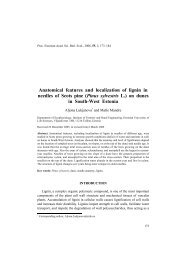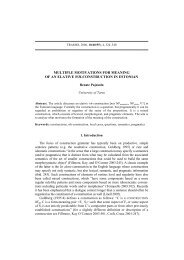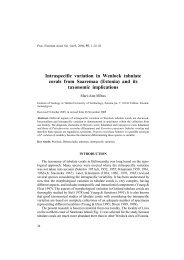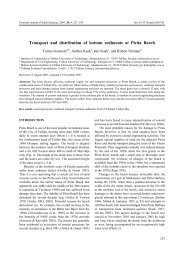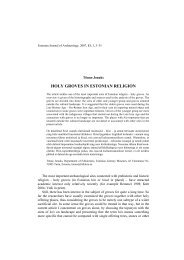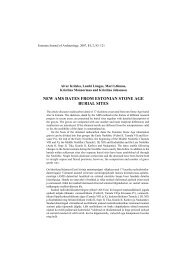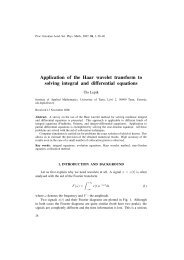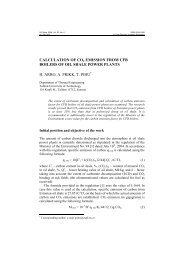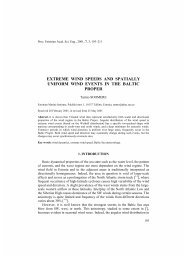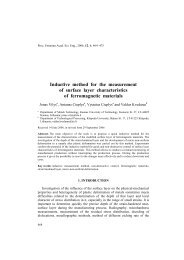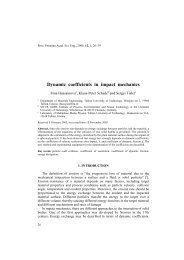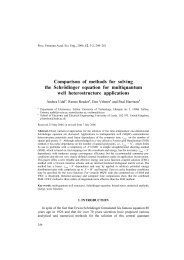PILLE PENJAM (Tartu) DEVELOPMENT OF THE MODAL ... - CEEOL
PILLE PENJAM (Tartu) DEVELOPMENT OF THE MODAL ... - CEEOL
PILLE PENJAM (Tartu) DEVELOPMENT OF THE MODAL ... - CEEOL
Create successful ePaper yourself
Turn your PDF publications into a flip-book with our unique Google optimized e-Paper software.
Pille Penjam<br />
the tulema-verb was almost clearly used modally; there were six more<br />
instances where the modal meaning could be regarded primary but an<br />
alternative interpretation is possible, too. The modal construction is absent<br />
in the oldest texts; the earliest examples date from the last decade of the<br />
17th century, e.g.<br />
(2) Agga et sesamma [=kirikuseaduse] sees sedda üxpeine on sädut/ mis<br />
keikennamist Kirko Asja on/ ja et mitte korra perrast echk issipeine on<br />
kirjotut/ mis Iutlusse Ammeti monnisuggust Asja Ajamissel tulle-p<br />
what come-3SG<br />
Kirko Wisi nink kombe echk monne mu issipeinse Luggu polest<br />
tähhelepan-na … (Kässi-Ramat 1699 : i—ii)<br />
pay attention-daINF<br />
’But that in this ecclesiastical book it is only provided what church<br />
matters are, and that it has not been written separately what one needs<br />
to pay attention to while taking care of the business of the preacher’s<br />
profession in connection with the ways and customs of the church or<br />
some other peculiar episode …’<br />
In the next centuries the modal use is already rather common; one can<br />
find such examples in almost all the texts from the 18 th and the 19 th centuries.<br />
However, the number of modal constructions by comparison with the number<br />
of all the occurrences of the tulema-verb is still rather small, with the exception<br />
of legal acts and texts providing various kinds of practical advice. Such<br />
a finding can be regarded as expected because the need to express modal<br />
meanings is much lower in narrative texts than in non-fiction texts.<br />
2.1. The meaning and functions of the modal tulema-construction in the<br />
old written language<br />
In modally interpreted sentences the semantics and functions of the tulemaverb<br />
(or rather those of the related construction) are similar to contemporary<br />
language — the tulema-construction is used to convey necessity<br />
and obligation modality, e.g.<br />
(3) Osta siis ennesele nisuggust riet, mis saksad nimmetawad: marliks; tee<br />
sest kotti, kellel pitkus 2 künart ja laius 11 ⁄4 künart pohjas on, seält<br />
tulle-b ta nenda kitsoke leika-da,<br />
come-3SG 3SG cut-daINF<br />
et kotti su laius ei olle ennam kui 1 ⁄2 künart. (Willmann 1782 : 195)<br />
’Buy then the kind of cloth that the Germans call gauze; make a sack<br />
from it that is two ells in length and the width from the bottom is 11 ⁄4<br />
ells; there you’ll have to cut it so narrow that the opening of the sack<br />
will not exceed 1 ⁄2 ells.’<br />
(4) Seddasinnas-t seädus-t tulle-b ka selle tallomehhe jures täita,<br />
this-PRT law-PRT come-3SG apply+daINF<br />
kes kulutanud, et koggodussest tahhab wäljaminna. (Seäduste-täitmisse<br />
tükkid 1845 : 10)<br />
’This law must be applied also to the farmer who has said that he<br />
wishes to leave the congregation.’<br />
170



